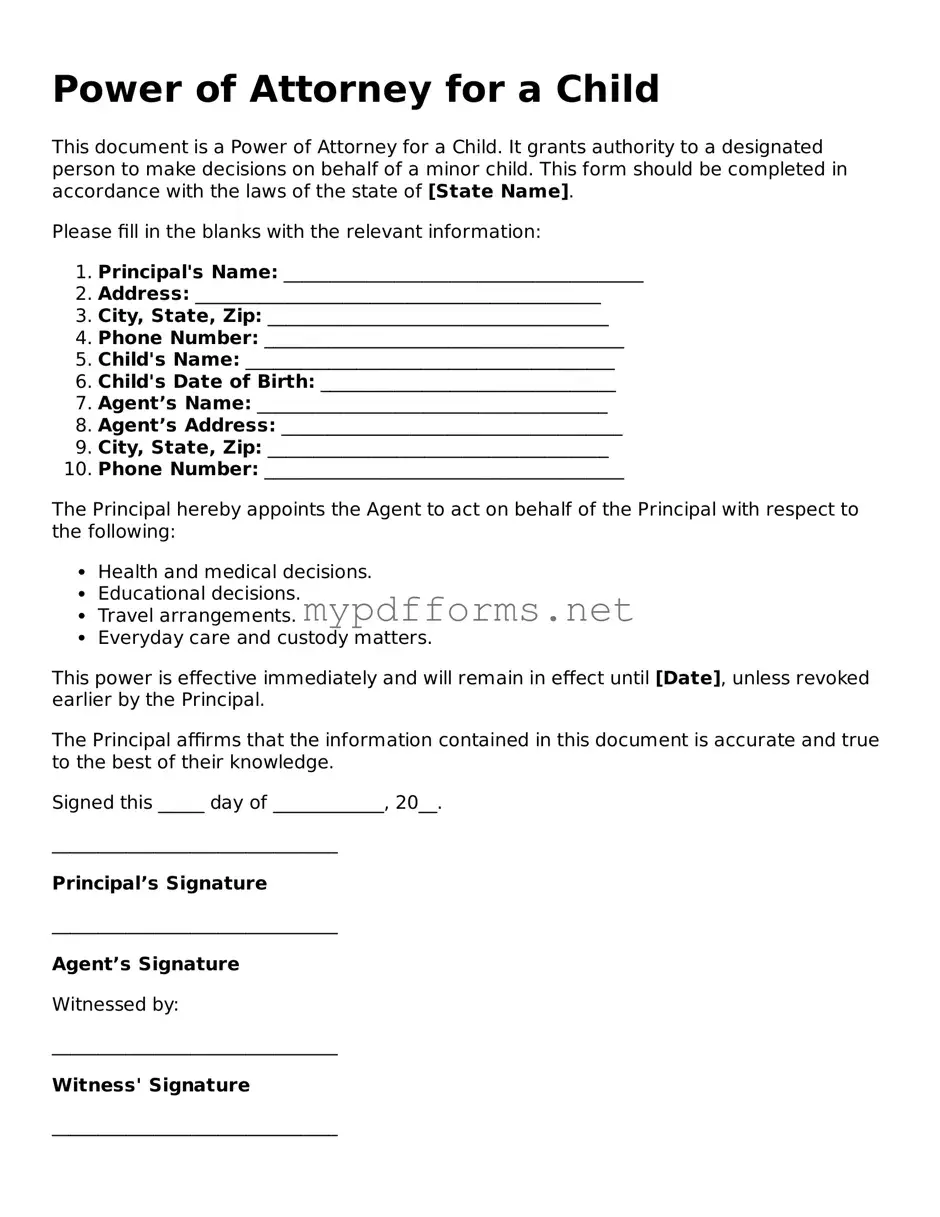The Power of Attorney for a Child form is similar to a Guardianship Agreement. Both documents establish a legal relationship where one party is granted authority to make decisions on behalf of a child. In a Guardianship Agreement, a designated guardian takes on the responsibility for the child's care and welfare, often in situations where parents are unable to fulfill their roles. This document is typically more permanent than a Power of Attorney, which can be temporary and specific to certain tasks or timeframes.
Another document that shares similarities is the Medical Power of Attorney. This form specifically grants someone the authority to make healthcare decisions for another person, including a child. In situations where parents cannot be present or are incapacitated, this document ensures that medical choices can still be made in the best interest of the child. While the Power of Attorney for a Child can cover a broader range of decisions, the Medical Power of Attorney focuses solely on health-related matters.
The Child Custody Agreement is also comparable. This legal document outlines the terms of custody arrangements between parents or guardians. Like the Power of Attorney for a Child, it addresses the care and upbringing of a child. However, a Child Custody Agreement typically arises during divorce or separation proceedings, establishing where the child will live and how parenting responsibilities will be shared, whereas the Power of Attorney is often used in different contexts, such as travel or temporary care situations.
The Consent to Travel form is another document that aligns closely with the Power of Attorney for a Child. This form is often required when a child is traveling without their parents or legal guardians. It grants permission for the child to travel and may designate another adult to accompany them. Similar to the Power of Attorney, it is used to ensure that the child’s welfare is prioritized and that legal permissions are in place for travel purposes.
A Foster Care Agreement also shares characteristics with the Power of Attorney for a Child. This document is used when a child is placed in a foster home, allowing the foster parents to make decisions regarding the child’s care and upbringing. Both documents empower individuals to act in the best interests of a child, but a Foster Care Agreement typically involves state oversight and is part of a more formalized child welfare system.
For those engaging in motorcycle transactions, understanding the crucial components of a bill of sale is essential. This document not only ensures a clear transfer of ownership but also protects the rights of both buyer and seller. If you're looking for a specific example, you can find a comprehensive resource at https://motorcyclebillofsale.com/free-georgia-motorcycle-bill-of-sale/, which provides a free Georgia Motorcycle Bill of Sale template that is both easy to use and legally sound.
The Adoption Agreement is another document that bears resemblance. It legally transfers parental rights from the biological parents to the adoptive parents. Like the Power of Attorney for a Child, it emphasizes the care and responsibility for the child. However, adoption is a more permanent solution, establishing a lifelong relationship, while a Power of Attorney can be temporary and limited in scope.
The Child Support Agreement can also be considered similar in its focus on the welfare of a child. This document outlines the financial responsibilities of parents towards their child. While the Power of Attorney for a Child pertains to decision-making authority, the Child Support Agreement ensures that the child’s financial needs are met, highlighting the holistic approach to a child's well-being.
The Special Needs Trust is another relevant document. This trust is established to manage assets for a child with special needs, ensuring they receive necessary care without jeopardizing government benefits. Similar to the Power of Attorney for a Child, it focuses on the best interests of the child, providing a legal framework to manage their needs effectively.
Lastly, the Child Care Authorization form is comparable. This document allows parents to designate caregivers for their child, granting them the authority to make decisions regarding the child’s daily care. While the Power of Attorney for a Child can be broader and more formal, the Child Care Authorization is often simpler and used for short-term arrangements, ensuring that a child is cared for in the absence of their parents.
